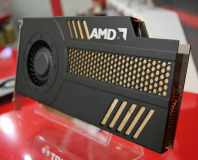Folding@Home
Creator: Stanford UniversityFolding@home is possibly the most successful GPGPU application at the moment, with ATI pioneering GPU-based folding years ago with its Radeon X1000 range of GPUs. Since then, folding has spread to the point where Nvidia has supported folding on all GPUs since its GeForce 8-series.
Folding is a client-based distributed computing application that simulates protein folding to aid our understanding of complex diseases such as Alzheimer's, Mad Cow Disease (BSE), CJD, ALS, Huntington's, Parkinson's disease, and many Cancers and cancer-related syndromes. To add some interest to the furthering of scientific and medical research doesn't hold any interest for you, Stanford also has team- and user-based leaderboards, so folding is also a competition.
To fold on your GPU, visit the High Performance Client page and download the latest version. The client downloads work units (aka 'projects') from Stanford, and each work unit is worth a certain amount of points.
You can monitor your folding progress via the FahMon tool, which will calculate how quickly your card can get through the current work unit and extrapolates a points per day (ppd) figure. You can join the bit-tech and Custom PC folding team (currently ranked fifth in the world) by using the team number 35947. Your contribution is valued.
While the original GTX 295 proved to a champion Folder thanks to it's effective utilisation of both GPUs, the newer version's revised design has meant that Folding@home is no longer able to utilise both GPUs, with PPD and power consumption falling as a result. However, an update to Nvidia's Forceware drivers will soon correct this, making the GTX 295 a champion folder once again, but still at the cost of electricity bill shaking power consumption.

MSI MPG Velox 100R Chassis Review
October 14 2021 | 15:04









Want to comment? Please log in.